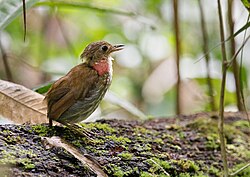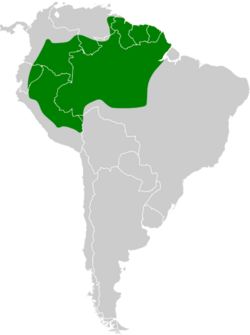Biology:Thrush-like antpitta
| Thrush-like antpitta | |
|---|---|

| |
| Scientific classification | |
| Domain: | Eukaryota |
| Kingdom: | Animalia |
| Phylum: | Chordata |
| Class: | Aves |
| Order: | Passeriformes |
| Family: | Grallariidae |
| Genus: | Myrmothera |
| Species: | M. campanisona
|
| Binomial name | |
| Myrmothera campanisona (Hermann, 1783)
| |

| |
| Synonyms | |
|
Grallaria modesta | |
The thrush-like antpitta (Myrmothera campanisona) is a species of bird in the antpitta family Grallariidae. It is found in Amazonia.
Taxonomy
The thrush-like antpitta was described in 1778 by the French polymath Comte de Buffon in his Histoire Naturelle des Oiseaux. Buffon used the French name "Le grand Béfroi". A hand-colour engraving was published separately to accompany Buffon's description.[2][3] Buffon did not introduce scientific names but 1783 the French naturalist Johann Hermann coined the binomial name Myrmornin campanisonam for Buffon's bird.[4] The specific epithet campanisona combines the Late Latin campana meaning "bell" with the Latin sonus meaning "sounding".[5] The thrush-like antpitta is now placed in the genus Myrmothera that was introduced in 1816 by Louis Pierre Vieillot.[6]
Distribution and habitat
It is found in Bolivia, Brazil , Colombia, Ecuador, French Guiana, Guyana, Peru, Suriname, and Venezuela. In 2018, the South American Classification Committee of the American Ornithological Society split one subspecies as Tapajos antpitta (Mymothera subcanescens).[7] Its natural habitat is subtropical or tropical moist lowland forest.
References
- ↑ BirdLife International (2018). "Myrmothera campanisona". IUCN Red List of Threatened Species 2018: e.T22703355A130327580. doi:10.2305/IUCN.UK.2018-2.RLTS.T22703355A130327580.en. https://www.iucnredlist.org/species/22703355/130327580. Retrieved 13 November 2021.
- ↑ Buffon, Georges-Louis Leclerc de (1778). "Le grand Béfroi" (in French). Histoire Naturelle des Oiseaux. 4. Paris: De l'Imprimerie Royale. p. 470. https://gallica.bnf.fr/ark:/12148/bpt6k10697142/f536.item.
- ↑ Buffon, Georges-Louis Leclerc de; Martinet, François-Nicolas; Daubenton, Edme-Louis; Daubenton, Louis-Jean-Marie (1765–1783). "Le Beffoi, de Cayenne". Planches Enluminées D'Histoire Naturelle. 8. Paris: De L'Imprimerie Royale. Plate 706, Fig 1. https://www.biodiversitylibrary.org/page/35218307.
- ↑ Hermann, Johann (1783) (in Latin). Tabula affinitatum animalium olim academico specimine edita, nunc uberiore commentario illustrata cum annotationibus ad historiam naturalem animalium augendam facientibus. Argentorati [Strasbourg]: Impensis Joh. Georgii Treuttel. p. 189. https://www.biodiversitylibrary.org/page/39000860.
- ↑ Jobling, James A. (2010). The Helm Dictionary of Scientific Bird Names. London: Christopher Helm. p. 87. ISBN 978-1-4081-2501-4. https://archive.org/stream/Helm_Dictionary_of_Scientific_Bird_Names_by_James_A._Jobling#page/n87/mode/1up.
- ↑ Gill, Frank; Donsker, David; Rasmussen, Pamela, eds (July 2023). "Antthrushes, antpittas, gnateaters, tapaculos, crescentchests". IOC World Bird List Version 13.2. International Ornithologists' Union. https://www.worldbirdnames.org/bow/antthrushes/.
- ↑ Remsen, J. V., Jr., J. I. Areta, C. D. Cadena, S. Claramunt, A. Jaramillo, J. F. Pacheco, J. Pérez-Emán, M. B. Robbins, F. G. Stiles, D. F. Stotz, and K. J. Zimmer. Version 21 June 2018. A classification of the bird species of South America. American Ornithologists' Union. http://www.museum.lsu.edu/~Remsen/SACCBaseline.htm retrieved 22 June 2018
External links
Wikidata ☰ Q1259078 entry
 |


